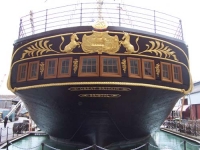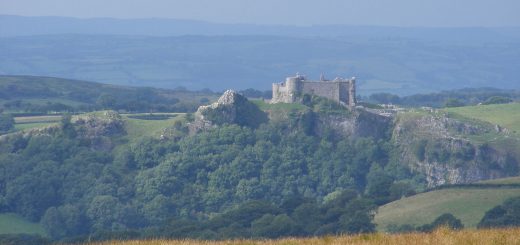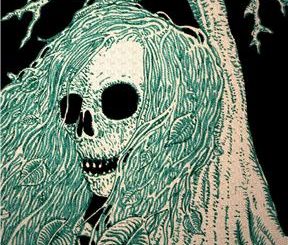The Tale of Nant Gwrtheyrn
When Thomas Pennant was touring Wales, he noted that the three farms on the Nant were Tŷ Hen, Tŷ Canol and Tŷ Ychaf respectively.
![Geoff Charles [CC0]](http://www.mysteriousbritain.co.uk/wp/wp-content/uploads/2012/02/Nant_Gwrtheyrn_going_to_ruin_6920059101-300x300.jpg) For the story, Tŷ Uchaf was occupied by the orphan, Rhys Maredydd and his sister, Angharad and Tŷ Hen was inhabited by a girl named Meinir and her father. Being cousins, the three children played together, but as they grew older Rhys and Meinir would tend to wander off together. One of their favourite places to hang out was a big old oak tree on the lower slopes of the Yr Eifl, the nearby mountain. As the years passed, Rhys and Meinir fell in love, and they were to be married. The wedding was to take place at the pilgrim church of Clynnog Fawr (St. Bueno’s) on the second Sunday in June. As the wedding day was imminent, family and friends started to arrive bringing the traditional wedding gifts and the food and drink for the wedding feast. The evening before the wedding, it is said that Rhys and Meinir sat underneath their favourite oak tree and Rhys carved in their names to the tree trunk. Meinir told Rhys that it was bad luck to do this before they were married, but Rhys reassured her that no bad luck could ever happen to them. It so happened that there was an ancient tradition in Nant Gwrtheyrn, known as the ‘wedding quest’ where the bride would hide on the morning of the wedding and the groom would have to hunt for her, so it’s hide and seek for adults. After breakfast, Meinir left her father’s house and ran for the hills. A short time later Rhys arrived at the house with his companions, but their way was barred by Meinir’s father, with the traditional exchange of pennillion where those on door step tried to get in, and the father tried to keep them out. When they eventually discovered that Meinir had gone, the hunt was on, but everywhere that they searched was fruitless. By lunchtime they decided to give up the search, and they concluded that Meinir had given them the slip and must be at the church in Clynnog Fawr (St. Bueno’s). When the men reached the church, Meinir was still nowhere to be seen so they started the search again, even lighting torches and looking throughout the night. The following day, it was obvious that something had happened to Meinir. They continued the search for a week and found no indication that Meinir had been to a particular location. The search parties gradually dwindled away, leaving only Rhys to search the valleys and mountains. He would even make pilgrimages to the ancient oak and would gaze out from there across the Nant, just as he had done in those happy days when he stood hand-in-hand with his beloved. After more than thirty years of searching, Rhys made his way to the ancient oak one more time bearing a lighted torch. There was roll of thunder over head and a bolt of lightning that struck the oak square on its trunk. With the smell of ozone and burning wood, the tree split in two revealing the hollow tree’s heart. There was another flash of lightning, and Rhys saw the bleached skeleton of a woman wearing a wedding dress. Rhys rushed to the body and the skeleton fell into his arms. It is said that he died of a broken heart there and then, and his body was found two days later with the corpse of Meinir still in his arms. They were buried in the same grave together.
For the story, Tŷ Uchaf was occupied by the orphan, Rhys Maredydd and his sister, Angharad and Tŷ Hen was inhabited by a girl named Meinir and her father. Being cousins, the three children played together, but as they grew older Rhys and Meinir would tend to wander off together. One of their favourite places to hang out was a big old oak tree on the lower slopes of the Yr Eifl, the nearby mountain. As the years passed, Rhys and Meinir fell in love, and they were to be married. The wedding was to take place at the pilgrim church of Clynnog Fawr (St. Bueno’s) on the second Sunday in June. As the wedding day was imminent, family and friends started to arrive bringing the traditional wedding gifts and the food and drink for the wedding feast. The evening before the wedding, it is said that Rhys and Meinir sat underneath their favourite oak tree and Rhys carved in their names to the tree trunk. Meinir told Rhys that it was bad luck to do this before they were married, but Rhys reassured her that no bad luck could ever happen to them. It so happened that there was an ancient tradition in Nant Gwrtheyrn, known as the ‘wedding quest’ where the bride would hide on the morning of the wedding and the groom would have to hunt for her, so it’s hide and seek for adults. After breakfast, Meinir left her father’s house and ran for the hills. A short time later Rhys arrived at the house with his companions, but their way was barred by Meinir’s father, with the traditional exchange of pennillion where those on door step tried to get in, and the father tried to keep them out. When they eventually discovered that Meinir had gone, the hunt was on, but everywhere that they searched was fruitless. By lunchtime they decided to give up the search, and they concluded that Meinir had given them the slip and must be at the church in Clynnog Fawr (St. Bueno’s). When the men reached the church, Meinir was still nowhere to be seen so they started the search again, even lighting torches and looking throughout the night. The following day, it was obvious that something had happened to Meinir. They continued the search for a week and found no indication that Meinir had been to a particular location. The search parties gradually dwindled away, leaving only Rhys to search the valleys and mountains. He would even make pilgrimages to the ancient oak and would gaze out from there across the Nant, just as he had done in those happy days when he stood hand-in-hand with his beloved. After more than thirty years of searching, Rhys made his way to the ancient oak one more time bearing a lighted torch. There was roll of thunder over head and a bolt of lightning that struck the oak square on its trunk. With the smell of ozone and burning wood, the tree split in two revealing the hollow tree’s heart. There was another flash of lightning, and Rhys saw the bleached skeleton of a woman wearing a wedding dress. Rhys rushed to the body and the skeleton fell into his arms. It is said that he died of a broken heart there and then, and his body was found two days later with the corpse of Meinir still in his arms. They were buried in the same grave together.
It was about fifty years later that the first reports of ghosts in Nant Gwytheyrn were reported. They began when a fisherman saw a skeletal figure drifting across the beach on a stormy night, and later many sightings of two ghosts walking hand in hand on the beach where reported, one with long hair and a long beard, the other wearing a white dress, and having hollow sockets where the eye’s should be.
The tale relates to an older myth relating to Nant Gwrtheyrn. It is said that in the beginning of the 6th Century, three monks on the pilgrimage from Clynnog to Ynys Enlli at the end of the Lleyn Peninsula found their way to Nant Gwrtheyrn. Here they encountered the small isolated community and wanted to build a church on the spot, but the local people on seeing these strangers began pelting the monks with stones. The monks retreated to safety and then cast down three curses on the community.
The first curse was that the Nant’s ground would never be holy and that no one would be buried in its soil.
The second curse was that the community of the Nant would succeed and then fail three times, and the third fall would be permanent;
The third curse was that members of the same family would never be allowed to marry one another.
It is said that on the evening of the monks’ departure all of the men in the village (who were fishermen) drowned in a storm that came from the north. With no men, the women had to leave, and hence the settlement of Nant Gwrtheyrn fell for the first time. Although this story has an obvious link to that of Rhys and Meinir, it is likely that it was propaganda by the Church of Rome which was attempting to bring the Celtic Church into the Roman Catholic fold.




Re: The Tale of Nant Gwrtheyrn
The Nant Gwrtheyrn Welsh Language and Heritage Centre can now be found where this abandoned former quarrying village was sited. Nant Gwrtheyrn or “Vortigern’s Creek” is thought to have been where Vortigern once took refuge.
In his ‘The Science of Fairy Tales’ (1891), Edwin Sidney Hartland gives the following description of a Changeling at Nant Gwrtheyrn.
Professor Rhys’ description of a reputed changeling, one Ellis Bach, of Nant Gwrtheyrn, in Carnarvonshire, is instructive as showing the kind of being accredited among the Welsh with fairy nature. The professor is repeating the account given to him of this poor creature, who died nearly half a century ago. He tells us: "His father was a farmer, whose children, both boys and girls, were like ordinary folks, excepting Ellis, who was deformed, his legs being so short that his body seemed only a few inches from the ground when he walked. His voice was also small and squeaky. However, he was very sharp, and could find his way among the rocks pretty well when he went in quest of his father’s sheep and goats, of which there used to be plenty there formerly. Everybody believed Ellis to have been a changeling, and one saying of his is well known in that part of the country. When strangers visited Nant Gwrtheyrn, a thing which did not frequently happen, and when his parents asked them to their table, and pressed them to eat, he would squeak out drily: ‘B’yta ‘nynna b’yta’r cwbwl,’ that is to say–‘Eating–that means eating all.’"